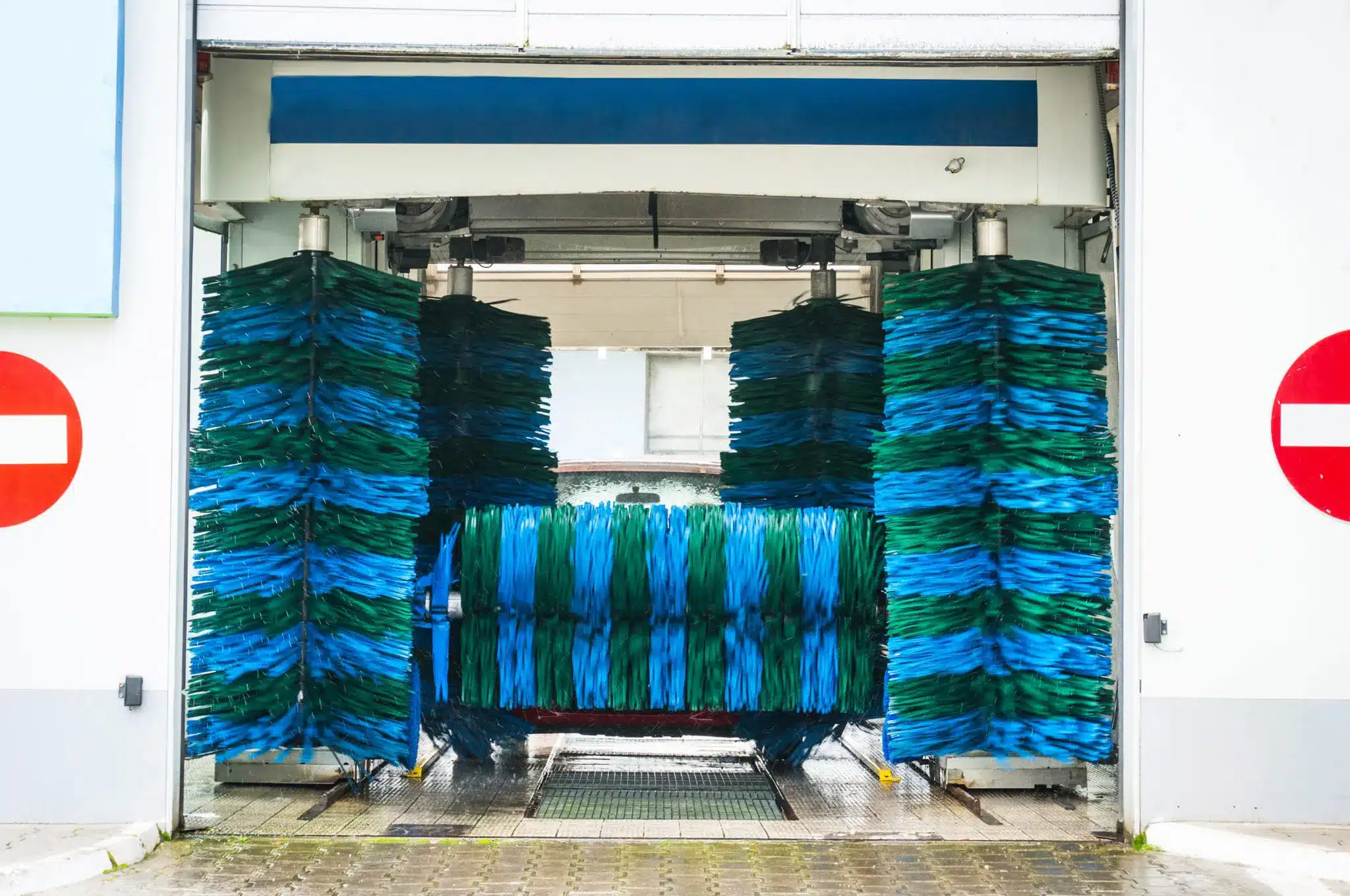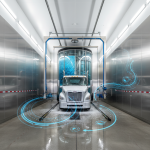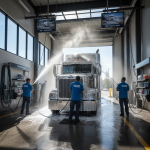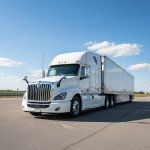Have you ever wondered if automatic friction wash systems pose a risk to your vehicle’s paint or wrap? Well, the truth is about to be revealed. In this article, we will delve into the debate surrounding automatic friction wash systems and their potential impact on your precious paintwork or wrap.
While these high-powered car washes are convenient and time-saving, concerns have been raised about the potential damage they can cause. Some argue that the brushes and friction created during the wash process can lead to scratches, swirl marks, and even peeling of vehicle wraps.
However, before you decide to steer clear of automatic friction wash systems altogether, it’s important to consider all the facts. Manufacturers have made significant advancements in wash system technology to minimize damage, using softer brushes and lubricants to reduce the risk of scratches.
Join us as we separate fact from fiction and explore the truth behind automatic friction wash systems. By the end of this article, you’ll be equipped with the knowledge to make an informed decision about which car wash method is best for your vehicle’s paint or wrap.
How automatic friction wash systems work
Automatic friction wash systems, also known as car wash tunnels, are a popular choice for many vehicle owners due to their convenience and time-saving features. These systems typically employ a combination of high-pressure water jets, rotating brushes, and cleaning agents to thoroughly clean the exterior of your vehicle.
As your vehicle enters the wash tunnel, it is guided along a track while various cleaning mechanisms are activated. High-pressure water jets blast away dirt and grime, while the rotating brushes help to scrub the surface of your vehicle. The brushes are usually made of soft materials, such as foam or gentle bristles, to minimize the risk of damage.
During the wash process, cleaning agents are applied to help break down stubborn dirt and enhance the cleaning effectiveness. Once the cleaning cycle is complete, your vehicle is rinsed with more water to remove any remaining cleaning solution.
Common concerns about automatic friction wash systems
Despite the convenience and efficiency of automatic friction wash systems, concerns have been raised about the potential damage they can cause to your vehicle’s paint or wrap. Some vehicle owners worry that the brushes used in these systems can leave behind scratches, swirl marks, or even cause the peeling of vehicle wraps.
While these concerns are valid, it’s important to note that manufacturers have taken significant steps to address these issues and minimize the risk of damage. Modern automatic friction wash systems incorporate advanced technology and materials that are designed to protect your vehicle’s exterior.
The impact of automatic friction wash systems on vehicle paint
One of the main concerns with automatic friction wash systems is the potential for scratches or swirl marks on your vehicle’s paint. While it is true that brushes can leave behind marks if not properly maintained or if the wrong type of brushes are used, most car wash operators take precautions to prevent this from happening.
Manufacturers now use softer brushes and specially formulated cleaning agents that are gentle on your vehicle’s paint. Additionally, these systems often incorporate lubricants to create a barrier between the brushes and your vehicle’s surface, reducing the risk of scratches.
It is worth noting that older or poorly maintained car wash systems may still pose a higher risk of paint damage. It’s essential to choose a car wash facility that invests in modern equipment and regularly maintains its wash systems to ensure the best possible care for your vehicle’s paint.
The impact of automatic friction wash systems on vehicle wraps
For vehicle owners with wraps, the concern extends beyond scratches and swirl marks. Wraps are made from vinyl or other specialized materials that can be more delicate than traditional paint. The friction created during the wash process can potentially cause the wrap to peel or lift.
However, like with paint, advancements in technology have led to the development of gentler cleaning methods for vehicle wraps. Car wash operators now use softer brushes and lower pressure settings to minimize the risk of wrap damage. Some facilities even offer touchless wash options that rely entirely on high-pressure water jets, eliminating the risk of friction-related damage.
If you have a vehicle wrap, it is crucial to choose a car wash facility that has experience in handling wrapped vehicles. They will be aware of the specific precautions needed to protect your wrap during the wash process.
Myth vs. reality: Debunking common misconceptions
Now that we have explored the potential impact of automatic friction wash systems on your vehicle’s paint and wrap, let’s debunk some common misconceptions:
Myth 1: Automatic friction wash systems always cause scratches and swirl marks.
Reality: While there is a potential for scratches and swirl marks, modern automatic friction wash systems are designed to minimize this risk. Soft brushes, lubricants, and proper maintenance all contribute to a safer car wash experience.
Myth 2: Automatic friction wash systems will cause vehicle wraps to peel or lift.
Reality: With advancements in technology and proper care, automatic friction wash systems can be safe for vehicle wraps. Car wash operators who specialize in wrapped vehicles will take the necessary precautions to protect your wrap during the wash process.
Myth 3: Automatic friction wash systems are the only option for a thorough car wash.
Reality: There are alternative car wash options available that can provide a thorough cleaning without the use of brushes or friction. Touchless wash systems that rely solely on high-pressure water jets are a great option for those concerned about potential damage to their vehicle’s paint or wrap.
Tips for protecting your vehicle’s paint and wrap in automatic friction wash systems
While automatic friction wash systems have come a long way in terms of minimizing damage, it’s always a good idea to take additional precautions to protect your vehicle’s paint and wrap. Here are some tips to consider:
1. Choose a reputable car wash facility: Look for a car wash facility that invests in modern equipment, uses gentle brushes, and maintains its wash systems regularly to ensure the best possible care for your vehicle.
2. Avoid automatic friction wash systems with outdated equipment: Older car wash systems may still pose a higher risk of paint or wrap damage. Opt for facilities that have newer, well-maintained equipment.
3. Consider touchless wash options: If you’re particularly concerned about potential damage, look for car wash facilities that offer touchless wash systems. These systems rely on high-pressure water jets to clean your vehicle without the use of brushes or friction.
4. Protect vulnerable areas: If your vehicle has vulnerable areas, such as mirrors or spoilers, consider using protective films or covers to shield them from potential damage during the wash process.
5. Regularly inspect your vehicle: After each wash, take the time to inspect your vehicle’s paint and wrap for any signs of damage. Catching and addressing issues early can help prevent further damage down the line.
Alternative car wash options for paint and wrap protection
If you’re still hesitant about automatic friction wash systems and want to explore alternative car wash options, there are a few alternatives to consider:
1. Hand washing: Washing your vehicle by hand using gentle cleaning products and soft microfiber cloths allows for precise control and minimizes the risk of damage. However, this method can be time-consuming and requires proper technique to avoid scratching.
2. Waterless car wash: Waterless car wash products are designed to clean your vehicle without the need for water. These products typically come in spray form and are applied directly to the surface, followed by gentle wiping with a microfiber cloth. While waterless car washes can be convenient, they may not provide the same level of cleaning power as other methods.
3. Professional detailing: If you want a thorough cleaning and protection for your vehicle’s paint or wrap, professional detailing services may be the way to go. Detailers use specialized techniques and products to deep clean, polish, and protect your vehicle’s exterior.
Expert recommendations for maintaining your vehicle’s appearance
Regardless of the car wash method you choose, maintaining your vehicle’s appearance is essential for long-term protection. Here are some expert recommendations to help you keep your vehicle looking its best:
1. Regular washing: Regularly washing your vehicle, regardless of the method, helps to remove dirt, grime, and contaminants that can damage the paint or wrap over time. Aim for at least once every two weeks, or more frequently if your vehicle is exposed to harsh conditions.
2. Use quality cleaning products: When washing your vehicle, use high-quality cleaning products that are specifically formulated for automotive use. Avoid harsh chemicals or abrasive cleaners that can strip away protective coatings or damage the paint.
3. Apply protective coatings: Consider applying protective coatings, such as wax or ceramic coatings, to your vehicle’s paint or wrap. These coatings provide an additional layer of protection against UV rays, dirt, and other contaminants.
4. Avoid parking in direct sunlight: Prolonged exposure to direct sunlight can fade paint and cause wrap materials to deteriorate. Whenever possible, park your vehicle in shaded areas or use sunshades to protect it from harmful UV rays.
5. Regular inspections and maintenance: Take the time to inspect your vehicle’s paint or wrap regularly for any signs of damage or wear. Addressing issues promptly can help prevent further damage and extend the lifespan of your vehicle’s exterior.
Conclusion: Making an informed decision for your vehicle
In conclusion, automatic friction wash systems can be a convenient and effective way to clean your vehicle’s exterior. While there are legitimate concerns about potential damage to your vehicle’s paint or wrap, advancements in technology and proper care have significantly reduced these risks.
By choosing a reputable car wash facility, considering alternative car wash options, and following expert recommendations for maintenance, you can ensure the longevity and appearance of your vehicle’s paint or wrap.
Ultimately, the decision on which car wash method to use depends on your personal preferences, time constraints, and the level of care you want for your vehicle. With the knowledge gained from this article, you can make an informed decision that best suits your needs and protects your vehicle’s paint or wrap for years to come.




